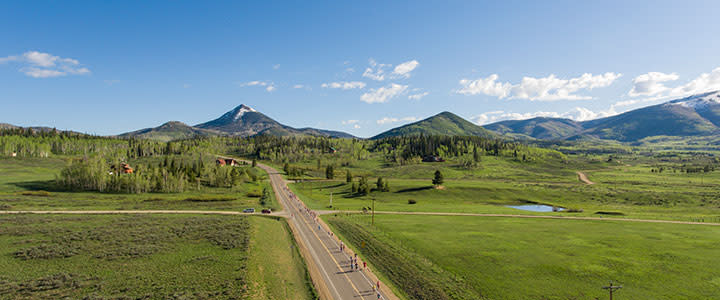
The Steamboat Marathon hasn’t become one of the best destination races in the country by accident. Every one of the 26 miles offers up spectacular beauty, from the white-capped waters of the Elk River to wildflower-dotted meadows to expansive views of the snow-capped Rocky Mountains. And with so much to do in Steamboat Springs, your entire crew will have plenty of ways to keep themselves busy before or after the race.
The Steamboat Marathon is an intimate race and race directors have created an atmosphere in which participants are treated like family. From the sunscreen being handed out at the starting line (make sure you use it!) to the support along the way, this highly organized race draws rave reviews from runners every year.
Of course, with the starting line at over 8,000 feet—that’s more than a mile above sea level—the altitude is an infamous obstacle for some participants. The extra-intense sun (the higher you go, the more intense it can be) is another consideration. But these challenges are well worth the effort. Here are additional tips on how to finish the Steamboat Marathon with a result you can be proud of—and a Colorado experience you’ll want to repeat.
Preparing for Elevation
First, a few words on racing at altitude. The thinner air at higher altitudes provides less oxygen for runners, and for those who aren’t used to this, side effects can include nausea, dizziness, trouble sleeping, and fatigue. The best way to mitigate these effects is to arrive early and let your body adjust slowly to its new surroundings. Ideally, you could roll into town at least a week before race day, but since that’s not always an option, you should plan to arrive two days beforehand. (Oddly enough, spending three or four days at altitude can leave the body feeling worn down as it tries to compensate for the lack of oxygen, so it actually makes more sense to race on day two after arriving if you can’t get here a week before.) In addition, some athletes find that taking iron supplements well in advance of the race can help mitigate the effects of altitude.
Another key factor in heading off the effects of altitude: proper hydration. As soon as you arrive in Colorado, start drinking plenty of water (and some locals also recommend upping your intake several days before your trip). Experts suggest doubling fluid intake to compensate for the drier air at higher elevations. Be sure to avoid alcohol before the race, as it’s dehydrating under any circumstances—and much more so at elevation. And, by all means, enjoy a celebratory post-race adult beverage or two, but go easy, since you’ll feel the effects more quickly.
Training for Elevation
One of the best ways to train for racing at elevation is to add more hill work to your training routine. This helps simulate the lower blood oxygen environment for your body. If you live in a place with few hills, you’ll have to get a little creative. Find a building with lots of stairs, or hop on a treadmill (use the incline function) to get your heart rate pumping.
Chances are good (almost guaranteed) that your race pace will be slower at high altitudes, so it’s best to use effort as a race guide instead of speed. Lots of runners use a heart-rate monitor to keep effort level in check. At elevation, it can also help to start out slower than normal and build intensity based on how you feel throughout the race.
Practice drinking fluids while training to simulate your race routine, too. Be sure to include some type of sports drink to replace sodium and electrolytes. And don’t use your sweat output as an indicator of how much you’re taking in, since perspiration is less in dry, high-country air.
Nutrition, while always important in long-distance races, can be even more so at higher altitudes. To ward off nausea, be sure to include easy-to-ingest items like gels or protein drinks into your race routine. Honey Stinger is the official hydration and nutrition sponsor of the Steamboat Marathon and will be served on the racecourse. Find their products in a store near you to start working them into your training.
Post-Race Recovery
Congratulations, you made to the finish line! While it might be tempting to go legs up right after the race, active recovery will help your body adjust, keeping discomfort at a minimum and healing as maximized as possible. Right after the race is over, be sure to walk and stretch (and, of course, rehydrate and refuel properly).
A long soak in an Epsom salt bath is another longtime recovery trick that many runners swear by. However, Steamboat offers a better option: a natural mineral bath soak! Old Town Hot Springs is right in town, walkable from the finish line, and it’s a fun place for the kids, too. It’s also possible to get a post-race massage on-site. Go ahead and make an appointment—you’ll have earned it.
Pre- and Post-Race Day Fun
While the race might be the highlight of a visit to Steamboat Springs, don’t miss out on all of the other adventurous options on offer. June in the Rockies is an ideal time for a hike, and Steamboat has a route that’s right for everyone. One of the biggest draws in the area is the easy quarter-mile hike to the not-to-be-missed Fish Creek Falls. The more adventurous, meanwhile, can tackle a longer hike to Upper Fish Creek Falls and Long Lake, deep in the Routt National Forest.
Wildflower displays in the mountains are reason enough to visit Steamboat, and a hike up Rabbit Ears Peak Trail won’t disappoint. After the post-race fatigue fades a bit, you may be ready to check out the challenging 5-mile (out-and-back) trail in search of brilliant wildflower displays. Another option for a day of outdoor adventure is Pearl Lake State Park, just north of Steamboat, with abundant options for high-alpine hiking, boating, paddleboarding, and fishing.
Where to Get a Good Night’s Sleep
Getting a good night’s rest is crucial for a good race, and Steamboat Springs is full of welcoming accommodations that range from rustic to luxe. Retreatia offers many options for condo-type lodging while Gravity Haus offers the amenities of a hotel with unique on-site amenities and is dog-friendly. Elevated Properties offers mountainside condos, while the Residence Inn offers a hotel-setting with the convenience of a suite layout. Some charming options in the downtown corridor include the historic Rabbit Ears Motel, which is within walking distance of the finish line, and the pet-friendly and affordable Nordic Lodge. For a more outdoorsy experience, the Steamboat Springs KOA is located just west of downtown, and you’ll also find a wide variety of camping options in area parks.
Where to Fuel
Whether you pounded out those 26.2 miles or were a rockstar spectator, you’ll be treated like a winner at the world-class dining options in Steamboat. Near the starting line are some of the best tacos in town at Salt and Lime. Find the best happy hour in town at Mountain Tap Brewery, which serves up award-winning house-brewed beer and an appetizer menu as intriguing as it is extensive. To kick back and make a night out of it, Aurum Food & Wine presents seasonal American fine dining with a riverfront view and an ever-changing menu.
Getting There
Flying into Steamboat Springs has never been easier thanks to the Yampa Valley Regional Airport, which is just 30 miles from Steamboat. There is no public transit from the airport into town so make sure to book your ground transportation in advance.
More airline options can be found at the Denver International Airport, which is about a three-hour drive to Steamboat. From Denver, choose from two options to get to Steamboat: three hours via I-70 W and US-40 W, or the slightly longer mountainous route past the famous Winter Park ski area (about four hours via I-70 W, CO-125 N, and US-40 W). But let’s be honest: Colorado’s landscapes are spectacular whichever way you come in, so you really can’t go wrong however you get to Steamboat Springs.






